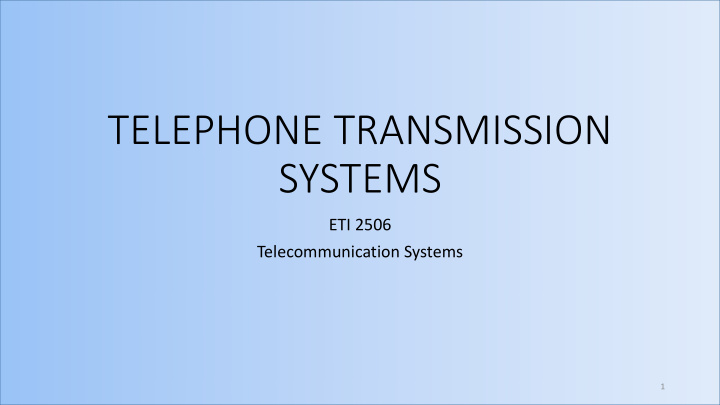



TELEPHONE TRANSMISSION SYSTEMS ETI 2506 Telecommunication Systems 1
BASIC ANALOGUE TELEPHONE Earphone (earpiece) The moving diaphragm produces varying sound that corresponds to the sound waves that were input at the transmitter RJ-SOCKET RJ-11 Socket connects to a PBX or Local Public Telephone Exchange Microphone (mouthpiece) Consists of a movable speaker diaphragm that is sensitive to both amplitude and frequency 2
CONVENTIONAL ANALOGUE TELEPHONE EXCHANGE - CROSSBAR DC SIGNALLING AC SIGNALLING On/Off Switch AC current at xx Hz indicates the status of rings the bell of the the subscriber subscriber 1300 Ω 𝑛𝑏𝑦 3
BASIC SIGNALLING – TRANSFER OF DIALLED NUMBER Signaling data Dial pulses have a duty cycles of 40% as follows: 0 – 10 pulses 1 – 1 pulse 2 - 2 pulses .. 9 – 9 pulses 4
DTMF SIGNALLING 1. Each button sends a dual frequency sine wave indicated by the corresponding row and column. 2. Terminal equipment could switch to character mode (Feature which is used for SMS on modern phones) 5
SUBSRIBER LOOP SIGNALLING 6
ORGANIZATION OF TELEPHONE EXCHANGES LOCAL AREA, TRUNK LINES, CARRIERS 7
COMMON CHANNEL SIGNALLING NO. 7 1. Common Signalling System 7 , also called SS7, was developed by the in order to increase the efficiency of the public voice system. 2. SS7 is a separate network whose duties are setting up, tearing down, monitoring, and routing calls on the PSTN. 3. SS7 is similar to TCP/IP in that it operates at several layers of the OSI model. And, like TCP/IP, SS7 is packet-based. It is a software-based system that operates independent of the voice transport. 4. SS7 works behind the scenes, so interacting with SS7 is something that the CO switch, not your phone or PBX, must do. SS7 is called common channel signalling because, unlike DTMF, it doesn't use the same frequency band, or even the same channel, as the voice transmission. 5. SS7 is used by all telecommunication systems — including cellular phone service providers, long-distance companies, and local exchange carriers (LECs). 8
SIGNALLING SYSTEM No. 7 (SS7) Fixed Telephone Subscribers Public Switched Telephone Network Telephone Exchange - A Telephone Exchange - B Packet-switched Signalling Network Fixed Telephone Subscribers 9
SUBSCRIBER LOOP • Any use of telephone channels involves two unidirectional paths, one for transmission and one for reception. • The local loop, which connects a telephone to a local exchange is a two-wire (2W) circuit that carries the signals • in both transmission directions. • Even asymmetrical digital subscriber lines (ADSLs) use this same 2W local 10
TELEPHONE TRANSMISSION SYSTEMS 1. Two-Wire versus Four-Wire 1. All subscriber loops in the telephone network are implemented with a signal pair of wires 2. Signals flow in both directions of transmission 3. Conversations are superimposed on the wire pair 4. Where PCM, radio or fibre are used, conversion is made to 4-wire 2. Two-Wire-to-Four-Wire Conversion 1. Basic conversion function is provided by hybrid circuits 2. Impedance matching is important 3. Impedance mismatch causes “echo” 11
IMPAIRMENTS IN TRANSMISSION SYSTEM • Telephone Networks suffer from the following impairments: 1. Signal Attenuation 2. Interference 3. Coupling between wires 4. Near-end crosstalk (From TX to RX at a common location) 5. Far-end crosstalk (From TX to RX at a distant location) 6. Noise 7. Echos 12
USE OF A HYBRID The basic conversion function is provided by hybrid circuits that couple the two directions of transmission as shown. 13
USE OF INTERCONNECTED TRANSFORMERS 1. Hybrid circuits have been traditionally implemented with specially interconnected transformers using a single or double coil circuit. 2. Shows a hybrid circuit implemented by a double coil. 3. More recently, however, electronic hybrids have been developed. 4. Ideally a hybrid should couple all energy on the incoming branch of the four-wire circuit into the two- 14 wire circuit.
COUPLING OF ENERGY 1. Ideally a hybrid should couple all energy on the incoming branch of the four-wire circuit into the two-wire circuit. 2. None of the incoming four- wire signal should be transferred to the outgoing four-wire branch. 15
ECHOS IN TELECOMMUNICATION • The effect of an impedance mismatch is to cause an echo, the power level of which is related to the degree of mismatch. 16
TYPES OF ECHOS There are primarily two types of echoes, i.e 1. Acoustic echo: involving the acoustic signal coupling between the microphone and the earpiece. 2. Hybrid Echo: involves part of the received signal being coupled to the transmit path in the hybrid in the PSTN. 17
HISTORY OF ECHO CANCELLATION • The first echo control systems in telecommunication were developed in the late 1960s. • They suppressed echoes developed on satellite communication systems. • The original designs has voice activated devices that turned off the return path depending on which between the received and transmitted signals was stronger. 18
DSP ACOUSTIC ECHO CANCELLOR 1. The echo cancellation processor forms two models for the received signal and the speech + echo signal which it subtracts to get a clean signal. 2. The Echo cancellation processor takes time to learn the pattern of the mixed signal (Local speech + echo) and the received signal. 3. Using Digital Signal Processing (DSP) Techniques, elements of the received signals are removed leaving a signal that is echo free. 4. The learning time for DSP echo cancellers should be less than 50ms. 5. Beyond 50ms, the system starts to loose syllables. 19
Recommend
More recommend